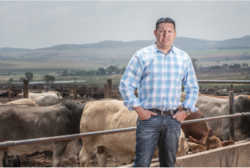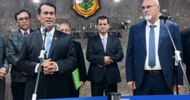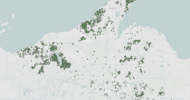
Matthew Karan, director at Karan Beef, at the company's feedlot in Heidelberg. (Photo: WALDO SWIEGERS/BLOOMBERG)
Karan Beef cashes in on exponential growth in demand from China
by FELIX NJINI and ANTONY SGUAZZIN
The world’s largest cattle feedlot is expanding SA beef exports beyond the Middle East to take advantage of surging demand in China and other Asian markets.
Karan Beef’s feedlot in Heidelberg is emblematic of a push by agriculture to boost exports of more niche products ranging from grapefruit and avocados to macadamia nuts. Increasingly, the emphasis is on high-value products rather than mass output of less lucrative crops like corn.
With 160,000 cattle on the property, which converted from dairy to beef production in about 1980, and half a million of the animals sent to slaughter every year, the 2,500ha operation is the biggest feedlot on a single site globally, according to director Matthew Karan.
The cattle are acquired from farmers around the country at about eight months’ old. They more than double in weight to about 420kg within four months with feed including molasses and gluten mixed in a production line-like factory that sees specially equipped trucks constantly topping up troughs in the pens. The operation accounts for 70% of SA’s beef exports and 30% of the local market.
“This is as good as you would see in Texas,” said Karan, one of three sons of founder Ivor, whose own father owned a cupboard-making business in Johannesburg.
The business has been exporting beef to the Middle East since the early 2000s and last year won access to China, doubling export volumes, Karan said in an interview at the feedlot. In the year to November it shipped 4.34-million kilograms of beef to China and 4.68-million kilograms to the Middle East.
“China is the market that’s putting pressure on us, China needs more beef.”
The company has had to work hard to promote SA beef, which is generally lean and “rose” in colour due to the local grading system, he said. That compares with the more marbled meat from the US and Australia, which contains more fat.
“China is the market that’s putting pressure on us, China needs more beef,” said Karan. “We have limited the volumes we send them because we don’t want to take away from the local market. There is potential for us to scale up exports, but this facility is pretty much at the maximum we could get to.”
China’s beef imports have jumped this year and are on pace for an annual record. Karan Beef is also looking at Malaysia as a new export market and is due to undergo an audit to ensure it meets the country’s halal standards early next year.
The beef industry more broadly is under pressure to increase production to meet local and international demand, said Gerhard Schutte, CEO at the Red Meat Producers Organisation. One possibility is building capacity of small-scale farmers, who own about 40% of the country’s livestock, but lack the competitiveness required for export markets, he said.
In October, the Karan family agreed to sell a 90% stake in the business to the Public Investment Corporation (PIC) and black-owned Pelo Agricultural Ventures for R5.2bn. The deal is the PIC’s largest to date in the agriculture sector, said head of corporate affairs Deon Botha.
The family will continue to manage the business for the foreseeable future, said Karan. An earlier offer of R6bn for the entire business by Chinese investors who wanted to export all of the output was rejected, he said.
“We have to ensure we leave our legacy properly,” Karan said. “Do you really want to be the guy that sold out SA?”













